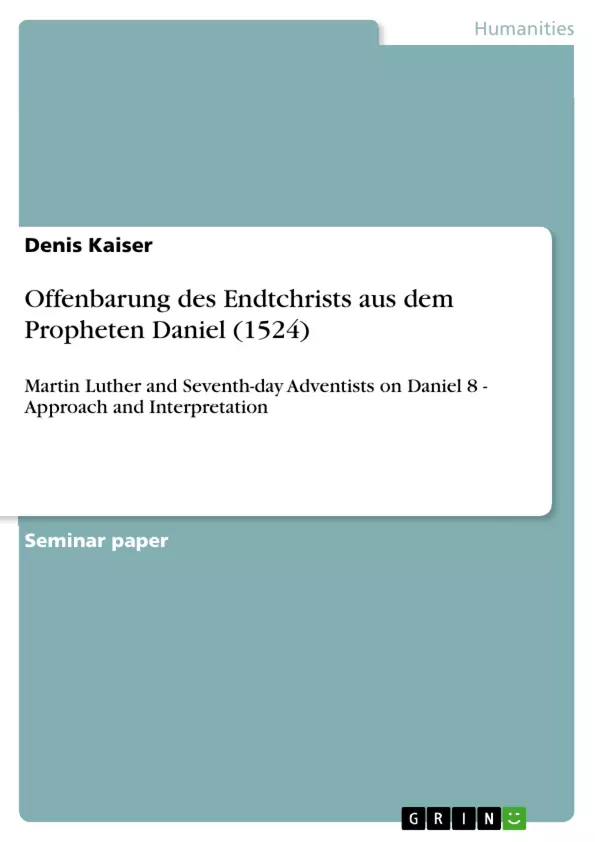Statement of the Problem: Andrews University holds in its Center for Adventist Research a considerable collection of tracts and pamphlets of the Reformation period. Some of these writings still wait for a more thorough investigation than has been possible in the past. One of these tracts that has not yet received the due attention is Martin Luther’s Offenbarung des Endtchrists: auß dem Propheten Daniel, wider Catharinum (1524), a German translation of the Latin Ad librum eximmii Magistri Nostri Magistri Ambrosii Catharini, defensoris Silvestri Prieratis acerrimi, responsio (1521). This book was written to Ambrosius Catharinus, and deals with the prophecy of Dan 8 on the manifestation of the End-Christ (the eschatological Antichrist). In the course of this paper I will refer to it simply as the Responsio. This Streitschrift could, however, be especially interesting for Seventh-day Adventists since their origin and message is undoubtedly connected to the interpretation of the prophecies of Daniel.
Purpose of the Research
The aim of this study is to get a better understanding of the historical background of Luther’s Responsio and how he interpreted the prophecies of Dan 8 in that book. Further, I want to highlight parallels and diversities between Luther’s approach and the Adventist approach to the prophecies of the Dan 8.
Methodology
First, the primary and secondary sources will be examined in order to comprehend the historical setting, in which the book was written as well as to identify the reasons for Luther to write his book. Its reception will be recognized in its translation into other languages, in the reaction of its recipient and of other contemporaries.
Second, the content of the tract will be summarized with a focus on Luther’s interpretation of and his approach to the prophetic text in order to understand which methods he used for the interpretation.
Finally, Luther’s interpretation, approach, and methods will be compared to the way modern Adventist scholars interpret the prophetic texts of the Bible to see similarities as well as differences, followed by an evaluation of both, Lutheran and Adventist prophetic interpretation.
Inhaltsverzeichnis (Table of Contents)
- I. INTRODUCTION
- Statement of the Problem
- Purpose of the Research
- Methodology
- Limitations
- II. BACKGROUND AND RECEPTION OF THE RESPONSIO
- Luther's Development of the Antichrist Motif
- The Origin of the Responsio
- The Reception of the Responsio
- III. BIBLICAL PROPHECIES: LUTHER'S INTERPRETATION AND APPROACH
- The Content of the Responsio
- Luther's Interpretation
- Luther's Approach
- IV. SIMILARITIES AND DIFFERENCES TO THE ADVENTIST INTERPRETATION AND APPROACH
- A Summary of the Adventist Approach and Interpretation
- A Summary of Luther's Interpretation and Approach
- A Comparison of the Interpretations and Approaches
- V. SUMMARY AND CONCLUSION
Zielsetzung und Themenschwerpunkte (Objectives and Key Themes)
This research paper examines Martin Luther's Responsio, focusing on his interpretation of the prophecy of Daniel 8 concerning the manifestation of the End-Christ. The paper aims to understand the historical context of the Responsio, Luther's interpretation of Daniel 8, and how his approach compares to Adventist interpretations of the same prophecy. The main themes explored in the paper include:- Luther's development of the Antichrist motif
- The historical and theological context of the Responsio
- Luther's interpretation of the prophecy of Daniel 8
- Luther's approach to biblical prophecy
- The comparison between Luther's and Adventist interpretations of Daniel 8
Zusammenfassung der Kapitel (Chapter Summaries)
- Chapter I: Introduction: This chapter introduces the subject of the research, which focuses on Martin Luther's Responsio, a tract written in response to Ambrosius Catharinus. The chapter outlines the problem of the Responsio's lack of attention, discusses the relevance of the topic for Seventh-day Adventists, and presents the purpose, methodology, and limitations of the research.
- Chapter II: Background and Reception of the Responsio: This chapter explores the historical context of the Responsio by examining Luther's development of the Antichrist motif, the origin of the Responsio, and its reception among contemporary scholars.
- Chapter III: Biblical Prophecies: Luther's Interpretation and Approach: This chapter dives into the content of the Responsio, analyzing Luther's interpretation of the prophetic text of Daniel 8 and the methods he employed for interpretation.
- Chapter IV: Similarities and Differences to the Adventist Interpretation and Approach: This chapter provides a summary of both Adventist and Lutheran approaches to interpreting the prophecy of Daniel 8, highlighting their similarities and differences. The chapter also compares the methods used by both perspectives.
Schlüsselwörter (Keywords)
This research focuses on the interpretation of the book of Daniel, specifically Daniel 8, with a particular emphasis on the concept of the End-Christ or the eschatological Antichrist. The study examines the historical background of the Responsio, Luther's approach to biblical prophecy, and the similarities and differences between Luther's and Adventist interpretations of the prophecy. Key terms include: Martin Luther, Responsio, Daniel 8, Antichrist, Eschatology, Seventh-day Adventist, prophetic interpretation, historical context, theological interpretation.- Quote paper
- M.A. Denis Kaiser (Author), 2008, Offenbarung des Endtchrists aus dem Propheten Daniel (1524), Munich, GRIN Verlag, https://www.grin.com/document/144951



